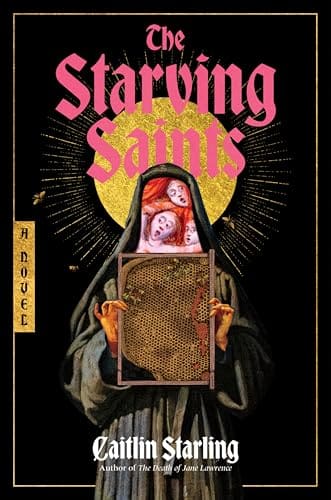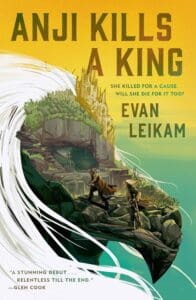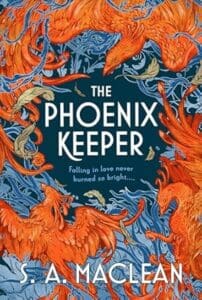
Synopsis:
Aymar Castle has been under siege for six months. Food is running low and there has been no sign of rescue. But just as the survivors consider deliberately thinning their number, the castle stores are replenished. The sick are healed. And the divine figures of the Constant Lady and her Saints have arrived, despite the barricaded gates, offering succor in return for adoration.
Soon, the entire castle is under the sway of their saviors, partaking in intoxicating feasts of terrible origin. The war hero Ser Voyne gives her allegiance to the Constant Lady. Phosyne, a disorganized, paranoid nun-turned-sorceress, races to unravel the mystery of these new visitors and exonerate her experiments as their source. And in the bowels of the castle, a serving girl, Treila, is torn between her thirst for a secret vengeance against Voyne and the desperate need to escape from the horrors that are unfolding within Aymar’s walls.
As the castle descends into bacchanalian madness—forgetting the massed army beyond its walls in favor of hedonistic ecstasy—these three women are the only ones to still see their situation for what it is. But they are not immune from the temptations of the castle’s new masters… or each other; and their shifting alliances and entangled pasts bring violence to the surface. To save the castle, and themselves, will take a reimagining of who they are, and a reorganization of the very world itself.
Review:
A rich, gothic slice of horror fantasy, Caitlin Starling’s “The Starving Saints,” is an otherworldly, queer, cannibal nightmare that is repulsive and intoxicating in equal measure. Gore-packed but not gratuitous, enchanting and suffocating, “The Starving Saints,” is a raw fever-dream that speaks to themes of devotion (or obsession), retribution and religion. Whilst it may not be a novel for the faint of heart, it certainly has a beating, bleeding one of its own and beneath the medieval trappings of Aymar Castle lies a wealth of commentary that slice clean into the present. A novel that should not be read on an empty stomach, or a full one in fact, this one is out in the world already. Thank you to Harper Voyager for my bloody gorgeous finished copy.
Aymar Castle has been under siege for the past six months. Food is running out, and after performing a miracle on the castle’s water supply, Phosyne, once a nun and now a “witch,” and “madwoman,” is expected to fix this problem too. No easy feat, progress is slow, much to the fury of the King, who commands that she work under the watch of knight Ser Voyne. Ser Voyne sees this task as beneath her, and with new pressure applied, perhaps the castle’s only hope is to continue praying to The Constant Lady and three saints. Then there’s Treila, now a servant girl, but once noble, she has a plan to exact vengeance upon Ser Voyne for her part in her family’s downfall, and access to a tunnel below Aymar. Beneath ground, she hears a voice, one that is ready to strike a deal with her. Above ground, arrives the divine.
Starling writes beautifully- “The Luminous Dead,” and “Last to Leave The Room,” are books that I discuss pretty regularly, and “The Starving Saints,” is no different. The prose has an allure to it that makes this novel near impossible to tear yourself away from, especially after the arrival of The Constant Lady and the saints. In an interview Starling discusses 4 distinct categories of cannibalism, of which “aesthetic cannibalism,” and “survival cannibalism,” appear prominently in “The Starving Saints.” I love the use of cannibalism as a metaphor, truly, but I’m also a huge fan of cannibalism for cannibalism’s sake, which is what we have here. Some of these passages were stomach turning, truly, yet there’s also a real ecstasy and intimacy to such a transgression, which is heavily played upon. I have a copy of The Graceview Patient that I plan to read very very soon, and mighty excited I am too.
I’ve disclosed before that myself and fantasy don’t generally get on. That is perhaps partly (definitely mostly) because I don’t tend to have the brain power nor patience for world-building and magic systems, although that wasn’t actually an issue I had here. I prefer my horror to be grounded in reality, it makes it infinitely scarier in my humble estimations, but again this was not an issue here, and that’s because “The Starving Saints,” is not a story confined to a medieval castle somewhere in Western Europe. That’s because it is perhaps ultimately, a novel about power, which seems to behave the same in any era. In any reality. Power is a commodity to be hoarded, a weapon to be wielded and a force that corrupts. Those who hold it, in differing ways and to differing degrees, all three of our main characters, certainly have an agenda.
Speaking of, for me, aside from perhaps the people-munching the highlight of “The Starving Saints,” has to be Starling’s characters, all of whom are challenging and flawed and indeed have that agenda we just discussed. My favourite perspective had to be that of Phosyne personally, but Ser Voyne was most food for thought. Voyne was once a hero, she craves purpose and was made for action. The indignity of being paraded around, and horror of redundancy is certainly one explored by Starling. It is also Ser Voyne, who believes most emphatically in The Constant Lady and starving saints, and is forced to confront the reality of them. All of this is complicated even further by Voyne herself. She is a war criminal, and we know her to be violent and have done horrible things, and yet she is haunted by these actions. Actions driven in the first place by love and loyalty and honor, most of which are stripped from her. I think she stole my heart, but it’s complicated.
Nick Cutter’s “The Queen,” meets Buehlman’s “Between Two Fires,” (but queer and ravenous) in this bacchanalian, cannibalistic nightmare- writ large. A novel that is fantastical and divine in so many ways, “The Starving Saints,” is also anchored by very real horrors. Seductive and festering, visceral and lush, Starling’s latest takes the sacred and profane and makes something beautiful.











Leave a Reply